Visiting Quaise
A few weeks ago, I had the incredible experience touring the Quaise facilities at Oak Ridge National Laboratory. Unlike other lab tours I've done, the folks at Quaise were actually so kind as to run their machine end-to-end. Thanks to a $30 webcam (that sadly malfunctioned due to high heat in the process), I could watch the whole thing before my eyes.
Disclosure #1: I am a small-time investor in Quaise. I am biased, but what they are doing is incredibly cool.
Disclosure #2: I am an armchair physicist at best. Some of these descriptions may be a little butchered.
What is Quaise?
Historically, geothermal has met less than 0.1% of the US energy needs. And yet, the total amount of thermal energy stored in the earth's mantle is massive, it's over two billion times our annual energy consumption! In fact, Eli Dourado estimates that there is 23,800x the amount of energy in the earth's crust as from coal, oil, gas, and methane combined.
Quaise is a new startup out of MIT which is trying to unlock that extra energy. The goal is to produce cheap, clean (and practically limitless) geothermal electricity.
The tech is still early, but incredibly promising. I think we'll start seeing geothermal generation begin in earnest in the next decade.
How does Geothermal work?
If you haven't spent a lot of time thinking about geothermal, here's the easiest way to think about it:
- we drill two holes, one for cold water, one for hot water down to an ambient temperature of about ~400 degrees C (enough for water to become supercritical), and we connect them via fissuring/fracking [1].
- we fill the holes with water (or some other working fluid) and create a closed loop
- we pump water from the surface down the cold borehole
- the water absorbs heat as it pushes towards the hot borehole
- supercritical water rises as steam up the hot borehole, spinning a turbine and generating clean electricity

This process is known as superhot rock geothermal, and it could be one of our best sources of clean electricity.
There are a handful of (mostly volcanic) places where temperatures near the surface are quite high and you only need to go a few kilometers deep: Iceland, Italy, and New Zealand to name a few. But these are very limited in number.
Everywhere else, we need to go deep. Very deep. Deeper-than-the-Mariana-trench deep.
As you might guess, drilling this deep gets really expensive. Most oil & gas drilling rigs use mechanical drill bits to drill down 1-3km. The deepest hole ever bored was the Kola Borehole dug by the Russians, and it took 10+ years to drill down to 12km depth.
For widespread deployment of super-hot geothermal energy, we need to drill to a depth closer to 10km, typically going through crystalline basement rock. This would be cost-prohibitive using traditional techniques from the oil and gas industry. Most of your time is spent pulling out broken mechanical drill-bits and replacing them.
The more we can efficiently drill low-cost, super-deep holes, the more potential sites there are for geothermal. That's where Quaise comes in.
Quaise: throwing away the drill-bit
Instead of having to constantly repair mechanical drill bits working at high temperatures and pressure, Quaise hopes to provide low-cost drilling to 10km depths via a high energy milimeter-wave.
You can think of this as a high-powered energy beam that will melt and vaporize rock (even at great depths). The plan is to then blow the vapor up to the surface using pumped gases.
The beauty of this approach is that it can all be done using energy generation from Earth's surface.
If you'd like to learn more about the mm-wave approach directly from the source, I recommend checking out Paul Woskov's 2015 talk "Into the Bedrock by Full Bore Millimeter-Waves".
Oak Ridge National Laboratory
I arrived Monday night at Knoxville airport, grabbed one of the last rental cars, and then drove from Knoxville to Oak Ridge. After a late-night McDonald's and check-in to the Holiday Inn Express, I woke up and headed out to Oak Ridge National Labs.

Why Oak Ridge?
One reason is that Quaise raised money from ARPA-E and the DOE to demonstrate a live drilling test (more on the milestones below).
The other reason is that ORNL is also one of the few places in the US that has working Gyrotrons. These are high-powered devices that basically drive a stream of resonant electrons. They've been used extensively with fusion research as a way of heating hydrogen into a plasma, and as part of non-lethal weapons research.
Architecture
Quaise's architecture consists of a few parts...
- the Gyrotron generates a high-energy mm-wave
- the beam travels many kilometers along a waveguide
- the guide hits rock which gets it up to temperatures where the rock vaporizes
- injected gas blows the vapor out of the hole to the surface
The demo we saw consisted of three of these pieces with a ~40ft waveguide.
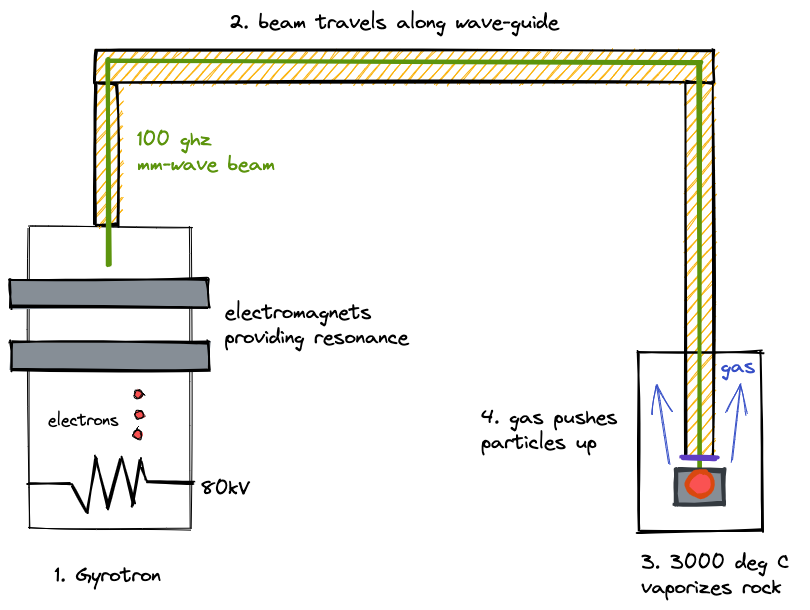
The Gyrotron
The gyrotron is the device that's responsible for generating the mm-wave energy beam. There's a set of transformers which create a very large voltage differential (80kV in the machine we saw, but it could be up to 1MW) that then drive dc current through a filament. The filament emits electrons which are then focused via a series of electromagnets.
The moving electrons in a magnetic field will generate electromagnetic waves at approximately 100ghz or so. The electrons themselves become coherent due to resonant standing waves in the magnetic cavity (sort of like an invisible laser beam).
Here's a picture of the Gyrotron. Note the three electromagnet bands around it, and the cooling tubes at the bottom. The wave will travel vertically up the Gyrotron. I'd guess this one was about 8ft tall or so.
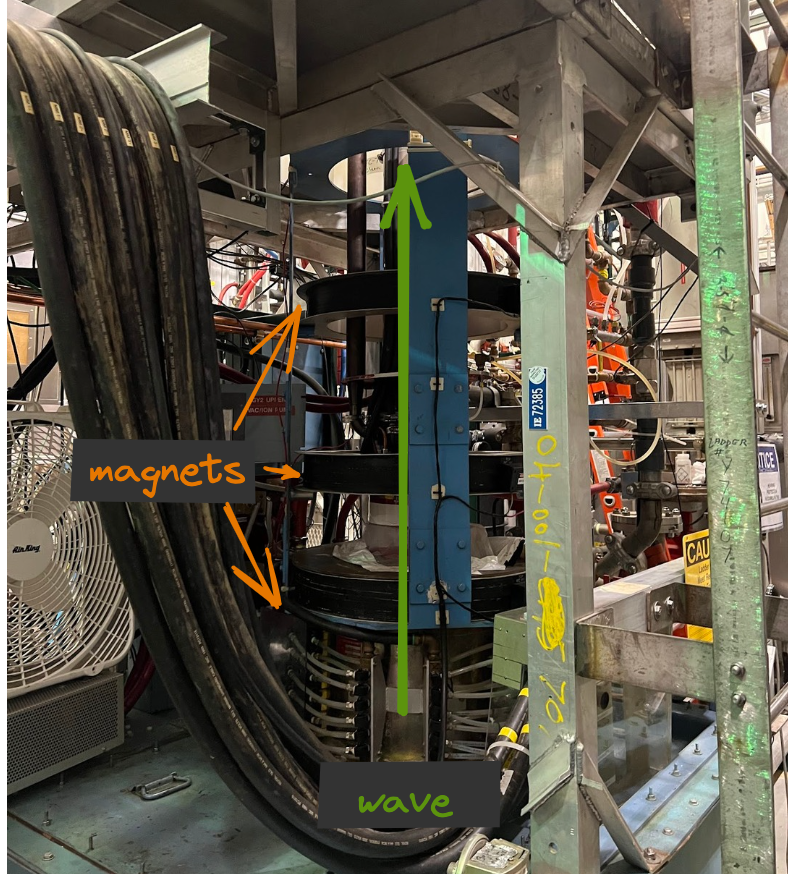
The voltage is supplied by giant power supplies sitting nearby...

Historically there hasn't been a very large market for Gyrotrons, on the order of tens per year are produced, and each one costs something like 700k-2.5m. The kind Quaise are using today get about 30-35% efficiency on output, but the Quaise team guessed that they could get up to something like 60% power efficiency if they can switch to superconducting magnets.
The Waveguide
Once the energy beam has started from the Gyrotron, it needs to be directed to the borehole. I got the impression that this is a relatively well-understood idea in the lab, but a non-trivial problem drilling at depth. After all, how do you send an energy beam down tens of kilometers into the ground?
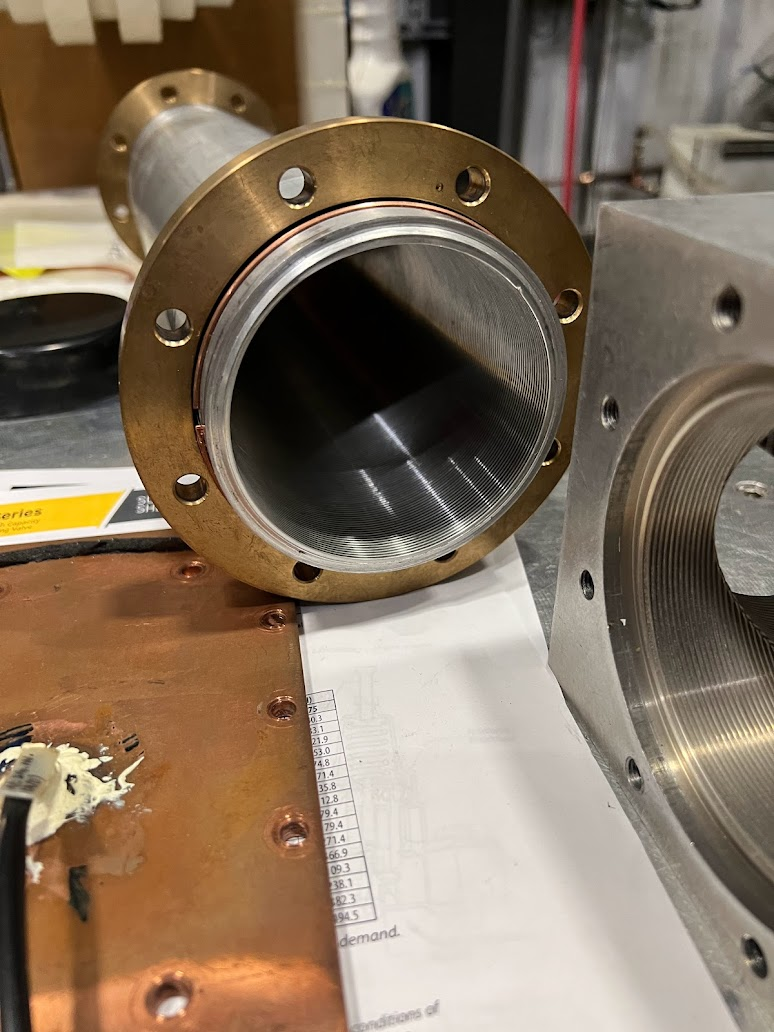
Quaise is using 'corrugated' waveguides (see the little ridges in the guide). This helps avoid electric field buildup on the walls of the wave guides. Today's wave guide costs about $1,000/m, which is incredibly expensive. The good news is that these waveguides can be re-used and can pretty easily 'reflect' the waves themselves around corners.
The wave guide will also act as the conduit for the gas, pumping it down into the hole so that the rock vapor can rise to the surface.
The window
Finally there's a window at the end to ensure that the mm-wave can drill into the rock, but that rock can't come back up the tube.

These window are tricky in that they 1) have to let the mm-wave pass through them and 2) have to withstand very high pressures and temperature to avoid damaging any part of the gyrotron with reflected energy or arcing from the plasma.
In Action
The Quaise team were kind enough to test the product end-to-end.
They started by locking up the room. In order to test, multiple people had to unlock their keys from the lockbox. When the team engaged the power supply, you could hear a noticeable "thunk" from the machinery next door.
On the lefthand side (next to Tim) you can see the power controls for the Gyrotron. On the right is the system monitoring, manned by Matthew.

The upper two units you see are to protect against any arcing from the plasma. The minute that happens, these will cut the power and the current flow to avoid damaging equipment.
Here's a closer look at the metrics being monitored:
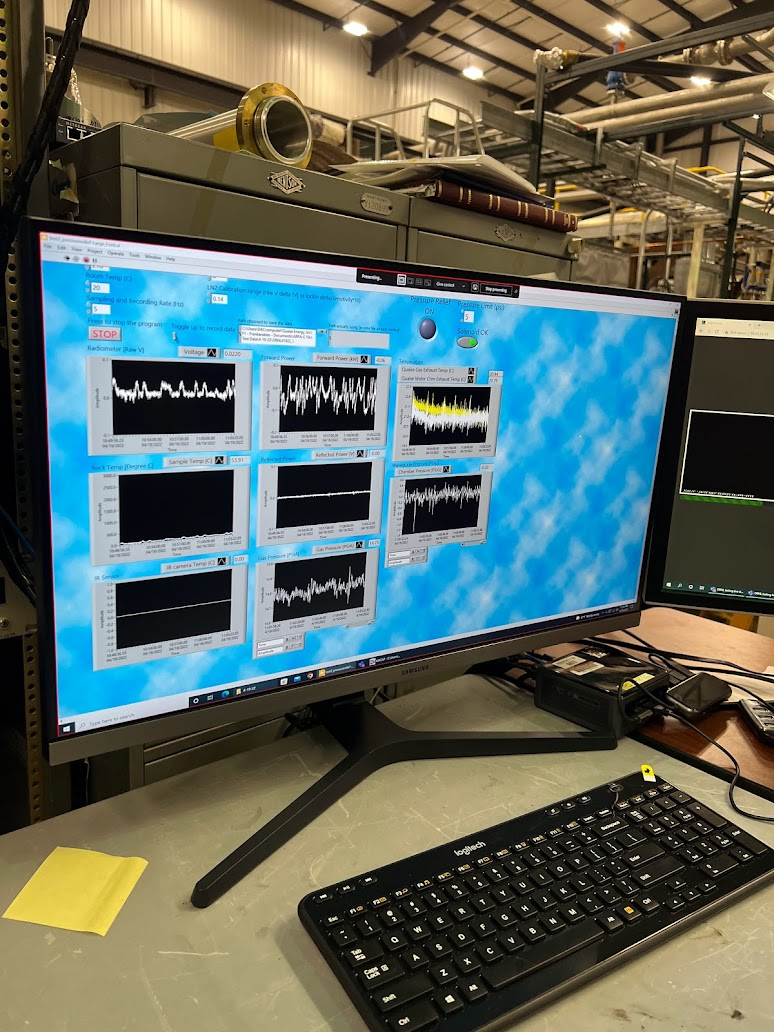
The most important metrics to watch here are the forward power and rock temperature.
Here's a shot of the first test run with the system fully engaged. On the right you can see the webcam inside the drum. The left-hand monitor is showing off an outside high-speed camera for diagnostics, as well as a bunch of labview charts inspecting the input voltage, forward power, and temperatures of the rock.
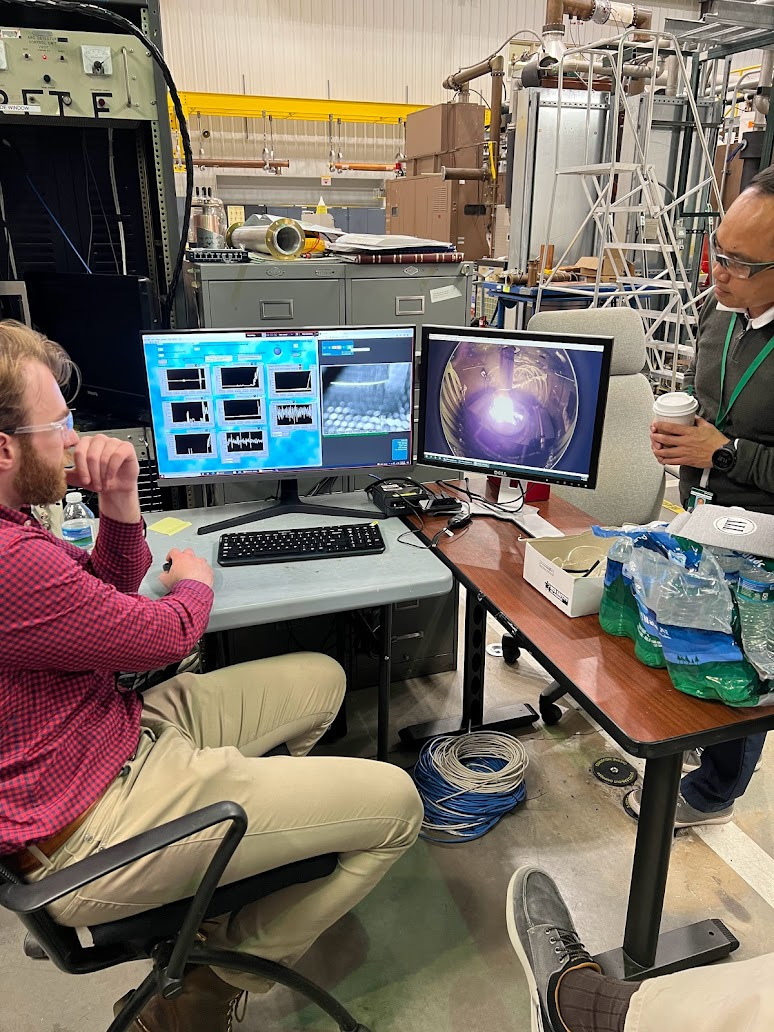
We tried 3 attempts. In each one, the power would get to about 12kw, and then we'd have some sort of arc which would kick in and cut the power. [2]
Milestones
Quaise views their milestones in terms of width:depth ratio. Most of the milestones are trying to prove out that the technology is actually able to reliably drill a hole, using nothing more than electricity.
Vaporized hole
Today, Quaise is able to melt rock. The next goal is to fully vaporize a core sample all the way through. You can see the following discarded samples from previous attempts. Each one is about the size of a dinner plate and a few inches thick.
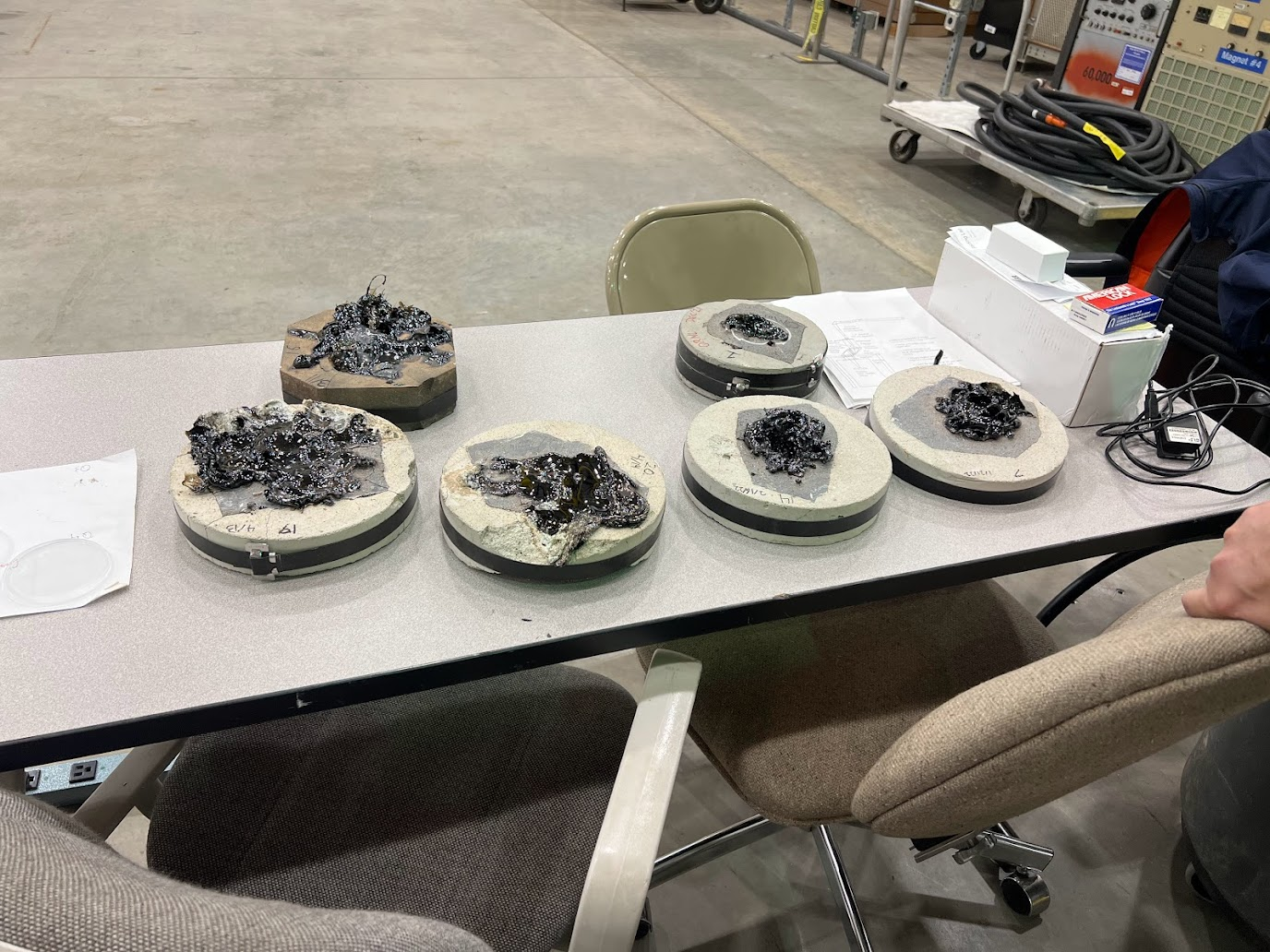
The white-ish surrounding is concrete which is poured to ensure the sample holds its shape. The muted gray is the crystalline form of the rock (Basalt). The shiny pieces are rock in its amorphous form, after it has rapidly cooled and doesn't have time to crystallize.
The next step is to try and apply more pressure (something like 70psi) to see if that will help.
1:10
This is the scale that will happen in the lab. Quaise engineers will keep the gyrotron stationary, and 'feed' rock up into it at a constant distance. The goal will be to drill about 10cm worth of rock.
1:100
Once the vaporization is working in the lab, it's time to move outside.
Right outside the lab, there's a 40ft deep well, about 10in across. The end goal of the ARPA-E funding is to fill the well with rocks and drill all the way to the bottom with nothing more than electricity and a purge gas.

To do this, the Quaise team will keep the Gyrotrons in their main building, but run the waveguide through a separate building and then out to the well site.
1:1000
Once the above milestones are complete, it's time to actually test at a real site. The Quaise team are looking at sites in NM and CO, where there's plenty of crystallized basalt available to test with.
Interesting Problems
Mode
One problem with using old Gyrotrons is that the mode frequency has some skew. What that means is that there are hot-spots in the area where drilling happens, rather than a focused energy beam that is able to channel more of the power directly from the Gyrotron to the rock.

You can see this in the above picture on the right-hand screen. Instead of having a 'single focused beam', there are 4 different hot spots. In order to achieve maximal power output, the team will have to figure out how to consolidate these frequency modes.
Containing plasma
Modeling plasma is notoriously difficult.
Generally speaking, this is a relatively cold plasma (only around 3,000 deg C). It should work sort of like a candle. There's heat which is applied to the rock. The rock starts melting and turns into a liquid. The liquid starts turning into plasma and vapor.
The trouble though is that plasma in practice tends to be very difficult to model and maintain. If not kept as a thin layer, the plasma will tend to just suck up all energy that is applied to it.
Additionally, the plasma has a tendency to 'arc', sort of like lightning where it will fly back up into the waveguide to follow the stronger electric field coming from the Gyrotron. The arc protectors immediately cut the current when this happens, but it's currently an unsolved problem.
Window material
The window which keeps unwanted particles coming up the waveguide have a lot of requirements. It needs to be incredibly strong to resist the pressure, heat, and plasma that are coming up to it. It also need to be made of a material that won't interfere with the wave.
Today, the team is using a mixture of quartz and sapphire windows. There's some talk of using a pure diamond plate... but doing so would easily cost hundreds of thousands of dollars.
Reflective substances
I hadn't really thought about this before talking , but hitting reflective substances can be really tricky. If the substance is too reflective, the energy won't be absorbed, and will instead send the energy back up the tube! It's the opposite of what we want.
Different types of substances also behave differently when exposed to high-energy mm-waves. Limestone, for example, has a tendency to crumble, and won't provide a consistent vaporization.
There's a lot more work to be done when it comes to testing out how various substances behave.
Hole siding
The hope is that as the Gyrotron bores the hole, it will begin to "vitrify" the sides of the borehole, and they turn to glass. These conditions haven't been fully tested as yet, and there's some question of whether the borehole will need additional pipes along the walls of the rock.
Better with pressure?
As the waveguide gets deeper and deeper into the ground, there's some thinking that the additional heat and pressure will actually make it easier to drill into the rock. I get the impression that we don't know a ton about the conditions that deep in the earth.
Tailwinds and thanks
If it isn't clear already, Quaise is doing incredible work. I'm extremely bullish on their ability to make widespread geothermal a reality. There's a few other tailwinds...
- regulatory ease: we're already very used to drilling holes in the ground, thanks to oil & gas. it's a very straightforward regulatory pathway
- abundant land: most of the western US has sufficient ground temperatures and crystalline rock for Quaise to work (see following chart). specialized sites aren't really required
- falling cost of electricity: combined with the falling cost of solar, Quaise's drills will become cheaper and cheaper to power as the cost of electricity falls
- demand for renewable baseload power: there's increasing demand to provide renewable 'baseload' energy at all times of day. only fission and hydroelectric power manage to do this right now. fission is more difficult from a regulatory standpoint (though it should get more support!). hydroelectric is limited in terms of potential sites. geothermal can navigate both.

Personally, I'm quite excited about a future where clean renewable energy is abundant. Quaise's approach seems to be one of the best shots at that future.
Many thanks to Carlos Araque, Henry Phan, and Matthew Houde for organizing the tour, and to Eli Dourado for turning me onto Quaise in the first place. If these problems seem interesting to you, Quaise is hiring across the board.
[1]: Technically, Quaise drills three holes, because the water coming out is less dense than the water being pumped underground.
[2]: Carlos tells me they've now hit 20kW